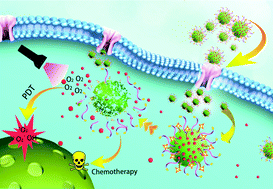A versatile and multifunctional metal–organic framework nanocomposite toward chemo-photodynamic therapy†
Abstract
Previously most of the applications of targeting components have been based on the enhanced permeability and retention effect achieved using folic acid, which consider the side effects of the targeting components to some extent. Herein, we report a new strategy to decorate the surface of MOFs using a pemetrexed (MTA) targeting molecule, affording a new drug delivery system of ALA@UIO-66-NH-FAM/MTA (ALA = 5-amino-levulinic acid and FAM = 5-carboxyfluorescein). The confocal microscopy and flow cytometry results showed that ALA@UIO-66-NH-FAM/MTA presented a better targeting effect compared to ALA@UIO-66-NH-FAM/FA (FA = folic acid) and indicated a gradually increasing tendency of the targeting effect with the increasing expression of folate receptors on the tumor cell cytomembrane. Furthermore, the cytotoxicity experiment indicates that the combination of chemotherapy and photodynamic therapy is a more effective therapy model than single chemotherapy and photodynamic therapy. This work demonstrates the first attempt at folic acid antagonist (MTA) modification for NMOFs, providing a new concept for the design of MOFs with folate receptor targeting capacity for clinical applications.



 Please wait while we load your content...
Please wait while we load your content...